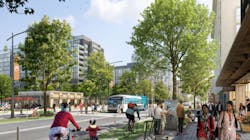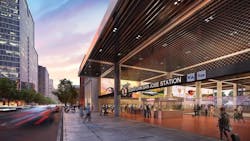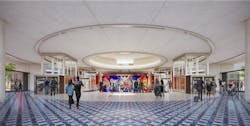Santa Clara VTA planning for four new BART Stations as part of BART Extension Project
The Santa Clara Valley Transportation Authority (VTA) is in the middle of planning for four new Bay Area Rapid Transit (BART) Stations.
In 2001, the VTA did a major investment study to determine the best transit solution for the highly congested I-880 and I-680 commute corridors on the east side of the Bay. Extending the regional BART system on the current alignment was determined the best alternative of 11 options studied. BART, when compared to other transit options, demonstrated the highest ridership potential and fastest travel times. Further studies of the planned extension project also demonstrated it would increase access to and from major employment centers throughout the Bay Area, enhance connectivity of regional transit services, promote economic development in the Silicon Valley and improve mobility for transportation-disadvantaged populations.
Like all major infrastructure projects, the plans and designs for the future BART extension are a long-term investment to meet long-term needs. As part of the long-term planning, a method called “modeling” is utilized to ensure the finished product ultimately will meet the mobility goals, provide equitable and accessible service and have the capacity to meet growing needs as cities, populations and congestion grow. The models include numerous inputs such as census data, population growth assumptions, housing and development plans where people travel to and from, employment, roadway capacity, auto, biking and walking trips, as well as economic factors. One of the things the model helps predict is the number of people who will ride BART coming to and from the four new stations. These projections are important to ensure VTA builds the stations large enough to accommodate the future riders for decades to come, as well as have some indication of a return on the investment.
Most transit agencies when planning projects utilize a customized model with unique local and regional inputs. While this is a prudent way to make projections as accurate as possible, it makes comparing projects from different agencies to qualify for grants and funding challenging. Because of this, the federal government has all transit agencies applying for grants, utilizing the same modeling system in their applications, so the projects can be compared to each other on a more equal playing ground. Because the model the Federal Transit Administration had VTA use in their funding application does not have all the inputs the VTA custom model has, it does not reflect the same forecasted information and shows a much lower projected ridership than VTA’s customized model based on local and regional information. The lower projected ridership in the modeling utilized for VTA’s federal grant application is not due to the impacts of COVID-19, which was not an input in either model.
In total, the four new BART stations are projected to have approximately 54,600 average weekday ridership in 2040, which represents 6.9 percent of total anticipated BART ridership, with a projected 27,900 daily ridership at the downtown San José Station alone. The two stations adjacent to San Jose State and Santa Clara Universities are projected to serve over 5,600 university student trips per day, not including trips taken by staff and faculty.
Currently, San José residents face the longest average commute (39 minutes) and experience the most hours of traffic-generated delay (81 hours per year) and the highest cost of congestion ($2,557 per year) of any urbanized area under 3,000,000 population in the United States. While Santa Clara County is forecast to have the largest projected growth in the San Francisco Bay Area by 2040 with over 550,000 new residents and almost 170,000 new jobs, there is no land available to build any new significant highway infrastructure. Once in service, the extension is estimated to reduce annual automobile vehicle miles traveled by 137.1 million miles. As a result, carbon dioxide emissions are estimated to be reduced by 60.2 tons and greenhouse gas emissions by 33,036 tons per year by 2040.
The Metropolitan Transportation Commission (MTC) is the transportation planning, financing and coordinating agency for the nine-county San Francisco Bay Area. MTC’s Plan Bay Area 2040 long range plan identifies VTA’s BART Extension Project as the No. 1 priority of the region for improving mobility. The project is a once-in-a-century opportunity to sustainably organize future growth around the future BART stations. Each of the four future station areas are designated as “priority development areas” in Plan Bay Area 2040 and are targeted for higher-density development in San José and Santa Clara’s general plans. TOD concentrates growth near job-rich areas, helps create walkable communities and maximizes the investment in transportation infrastructure.


